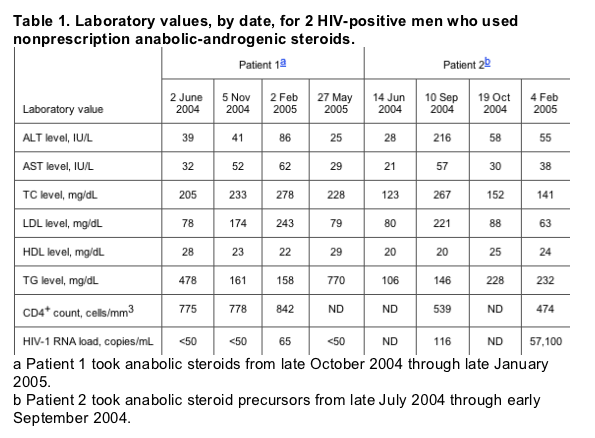| |
Reversible Hepatic and Lipid Abnormalities with Nonprescription Anabolic-Androgenic Steroid Use in 2 HIV-Infected Men
|
| |
| |
CORRESPONDENCE
Clinical Infectious Diseases July 1, 2006;42:151-152
Graham E. Abra and Joseph T. Lonergan
Department of Medicine, University of California, San Diego
SIR: Hepatitis is a common adverse reaction to HAART, and dyslipidemia is a complication of both HAART and HIV infection [14]. False attribution of adverse trends in liver and lipid test results to HAART toxicity may lead to unnecessary changes of or discontinuation of therapy. We identified 2 HIV-infected men who developed transaminase and low-density lipoprotein level elevations while taking nonprescription anabolic-androgenic steroids (AASs).
Patient 1 was a 43-year-old white, homosexual man with a CD4+ lymphocyte count of 813 cells/mm3 and an HIV-1 RNA load of <75 copies/mL who had been taking a regimen of lopinavir-ritonavir (400 mg of lopinavir and 100 mg of ritonavir twice daily); abacavir, lamivudine, and zidovudine (300 mg of abacavir, 150 mg of lamivudine, and 300 mg of zidovudine twice daily); and tenofovir (300 mg daily) since October 2002. Other past medical history included allergic rhinitis and insomnia, for which he received fexofenadine, intranasal fluticasone, and zolpidem.
He started using illicit AASs in October 2004. The results of his laboratory tests are shown in table 1. He took nonprescription oxandrolone (30 mg daily) with intramuscular testosterone cypionate (400 mg every 5 days) and boldenone undecylenate (400 mg every 5 days). He discontinued oxandrolone in November and switched from testosterone to trenbolone acetate (200 mg intramuscularly every 5 days) in mid-December. He discontinued all anabolic compounds in January 2005. In addition to the abnormal transaminase and low-density lipoprotein levels noted in table 1, the patient developed hypertension. He did not abuse alcohol or start any other new medications, and the results of his viral hepatitis serologic tests were unremarkable. His thyrotropin, creatinine and glucose levels were normal. Using the Framingham scoring system, we figured that his 10-year risk for a major coronary event increased from 3% to 13% when he was taking steroids [5].

Patient 2 was a 43-year-old white, homosexual man with a CD4+ lymphocyte count of 539 cells/mm3 and an HIV-1 RNA load of 116 copies/mL. He was not receiving HAART. His past medical history included hypertension, hypogonadism, allergic rhinitis and diverticulosis. His took intranasal memetasone and testosterone cypionate (100 mg intramuscularly, weekly).
He started a 6-week regimen of AAS precursors in July 2004. In addition to his prescribed testosterone, he started taking an over-the-counter muscle-building product (Winni Depot, German American Technologies; 2 pills 3 times per day; each pill contained 10 mg of methyl-1-testosterone, 50 mg of 5-androstenediol, 50 mg of beta-hydroxyecdysone, and 100 mg of a "proprietary amplifier blend" [6]) and a 5% liposomal steroid solution (Finigenex, PharmaGenX; 6 mL 3 times per day; the solution contained 25 mg/mL of 19-norandrosta-4, 9-diene-3, and 17-dione). He discontinued use of these compounds in September 2004. The results of his laboratory tests are shown in table 1. He did not abuse alcohol or start taking any other new medications, and his viral hepatitis serologic test results and glucose levels were unremarkable. When he was taking these steroid supplements, his 10-year calculated risk of coronary heart disease rose from 1% to 10% [5].
According to a recent review of the literature about AAS use, the prevalence of steroid use among active individuals ranges between 6.2% and 38.4%, and the prevalence among inactive individuals ranges between 0.4% and 9.6%. The prevalence rates obtained from many of the studies did not distinguish single use from prolonged use [7]. Only 1 study has specifically looked at AAS use by HIV-positive, homosexual men; it was found that the prevalence of AAS use was 31.7% [8]. The study did not differentiate therapeutic from nonprescription use.
Lipid and transaminase level elevations have been reported in AAS users [9]. We convinced our patients to discontinue AAS use by explaining the long-term cardiovascular implications of their lipid level abnormalities in particular. The importance of asking patients about steroid use is highlighted by a recent study that shows that only 44% of AAS users had revealed their use to physicians [10].
Patient 1 obtained his steroids illegally from an individual supplier; patient 2 bought his (now banned) steroid precursors over the counter. Internet sources are also readily available. Using the Internet search engine Google, we found that the phrase "buy steroids" resulted in 1,900,000 hits. Many of these Web sites provide AAS dosing instructions and regimens, but downplay the drugs' potential hazards.
In summary, prevalence data on AAS use in HIV-positive, homosexual men is sparse, but limited results show that the prevalence of use may be high. AAS use may confound interpretation of liver and lipid level abnormalities in HIV-infected patients who receive HAART. AASs are readily available, and vendors rarely reveal their dangers. HIV care providers should routinely screen their patients for steroid use and educate them regarding the drugs' adverse effects.
|
|
| |
| |
|
|
|